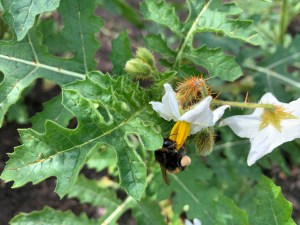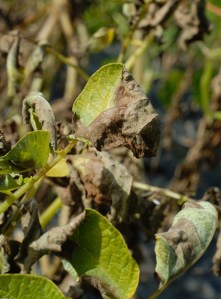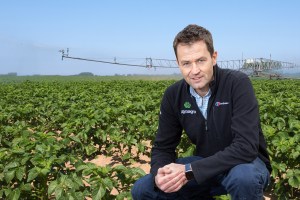Written by CPM Magazine from CPM Magazine
Download PDF
Potato cyst nematodes have always been one of those ‘hard to control’ pests and growers are turning to cultural controls to support a dwindling armoury of chemistry. CPM visits a Cambridgeshire farm where trap cropping is being evaluated.
By Rob Jones
Potato cyst nematodes can lead to loss of saleable yield and the pest costs the GB potato industry around £25.9m per year, according to researchers at Harper Adams University.

Trap crops from the same family as potatoes, such as Solanum sisymbriifolium (Decyst Prickly), cause PCN eggs to hatch but as they’re not able to complete their lifecycle, the numbers in the soil are reduced.
Trap crops are one of a range of non-chemical methods which may help growers address challenges to the potato sector from PCN, believes Hutchinsons agronomist David Rushmer. He’s looking at the part they can play with John Scott, who farms in Cambridgeshire with his son Michael.
“Tackling the pest is challenging because of the long persistence of viable cysts in the soil in addition to a reduction of chemical options available,” says David.
John has found PCN to be a problem in parts of his land at Friday Bridge, near Wisbech. Even where potatoes haven’t been grown for 12 years and volunteers have been well controlled, PCN have proved to subsequently be a headache.
“As a result, we’ve followed the assumption that we’re dealing with Globodera pallida populations here, which take longer to decline.”
And it was this that drove his decision to trial a trap crop. Speciation tests have gone on to prove that John’s assumption was indeed right, with the farm’s PCN population proving to be 100% G.pallida.
Explaining how trap crops work, Hutchinsons root crop technical manager Darryl Shailes says trap crops are in the same family as the potato and, consequently, their root exudates stimulate the PCN cysts to hatch. “However, when this happens the female nematodes aren’t able to form cysts and therefore no eggs are produced. This should reduce population density.”
There are a number of different members of the Solanum family that have the potential to work in this way, including Solanum sisymbriifolium, S. nigrum and S. scabrum.
When approached by John and David, James Lee of Produce Solutions recommended and supplied DeCyst Broadleaf. He says it’s been seen to establish more quickly in cooler temperatures than DeCyst Prickly (S. sisymbriifolium), which needs higher soil temperatures. In addition, research undertaken by the University of Warwick found that S. scabrum can reduce PCN by up to 80%, he adds.
To facilitate drilling, the seed was mixed with inert lentils which act as a filler for a conventional drill, says James, and drilled (with the lentils) at a rate of 20kg/ha.
He adds that while biomass is important as it indicates root size, he has also found that the ‘zone of influence’ of the plants is larger than their size, particularly in wetter conditions, as the PCN are attracted to the plants.
A former Writtle scholar, John held back from planting until the middle of June because the spring was very dry and he was waiting for rain to be forecast. He notes he’d also been advised that DeCyst Broadleaf shouldn’t be planted at a depth of more than 2cm.
“We broadcast the seed and then rolled it in, and we were lucky enough to receive 12mm of rain the next day which set the crop up for germination,” says John.
Although there was no further rain until mid-August, the crop was tall, vigorous and healthy, he notes. “As it was following a recently harvested crop of spring malting barley there was sufficient residual N, P and K in the soil, so no further fertiliser was applied.”
As a frost-susceptible plant, the trap crop of DeCyst Broadleaf can be left to die off naturally or chopped and incorporated after a minimum of 12 weeks to add organic matter to the soil, adds David.
Soil sampling has revealed that no PCN eggs have been found in the trap cropped field. “While it doesn’t mean the land is PCN free, it is an indication that the trap crop has been doing its job,” he adds.
Reflecting on the history of the farm, John recalls that it belonged to a beef farmer in the late 1920s. “At that time, there would have been grass leys and fodder crops for the livestock, rather than just arable cropping,” he says.
“Unfortunately the beef farm wasn’t profitable and was repossessed by the bank, however it struggled to rent the farm out. At this time, my grandfather had three sons nearing school leaving age and he wanted to let each of them to have a farm to run and it was offered to my grandfather rent-free for three years in the 1930s.”
Those were still difficult times, he says, and a simple rotation of wheat and potatoes was grown numerous times in a row. During the Second World War, the government backed War Agricultural Executive Committee (also known as War Ag) had executive powers which farmers were required to follow. They were told to lengthen the rotation to five years, advising that six would be better.
So the farm changed its rotation to five years and continued until the 1950s, by which time they had an PCN problem. However, in the 1960s they started growing Maris Piper which suppresses the then-dominant PCN species G. Rostochiensis as it is resistant to this strain. Consequently, G. pallida got the upper hand and is the species the Scott family is now seeking to control.

Farming with his father John, Michael Scott says the farm has been in the family since the 1930s.
John’s father had taken over running the farm and took the opportunity to buy it with a mortgage with the Agricultural Mortgage Association (AMC) at 12% interest. He continued with potatoes in the rotation and other varieties grown over the years have included Cara, and more recently he has been planting Markies and Sagitta. All the crops are unirrigated.
Attempts had been made over a number of years to get on top of the PCN problem. This included using a nematicide before planting and also trialling PCN resistant varieties.
“Despite recommendations, these resistant varieties didn’t work well for us; one multipurpose variety went pink when it was cut, while another was very susceptible to blackleg and had very few tubers per stem.
“We’re considering trying another resistant variety, but it has to be one that our customers demand.”
Although cyst counts were between one and three last year, David points out that as the pest tends to occur in hotspots across the field, detection can be difficult.
Sometimes differences in crop development can help to identify affected areas, and John has found potatoes planted on the silty roddons (raised land over dried water courses) often tend to suffer more PCN-like symptoms. This may be because these soil conditions (silt and clay filled beds) create a worse effect than in other areas of the field.
“It’s a good idea to map PCN populations with sample sizes of 50 cores per hectare this will be more accurate than hand sampling,” adds Darryl. “It would be interesting to see if a TerraMap survey would pick out the roddons. The two systems could then be utilised with a targeted programme to bring numbers down.”
He adds that Hutchinsons are conducting a wide range of trials to help farmers address the issues they are facing. These include research on wireworm and free-living nematodes (FLN), amongst others.
Resistance management to the fore

A few isolates of the comparatively new blight strain – EU_43_A1 – have been found to have resistance to the CAA group of blight fungicides in sensitivity testing in Denmark.
Reports of a single strain blight pathogen in Denmark, where some samples were shown to be resistant to the highly important carboxylic acid amide (CAA) group of blight fungicides, has reinforced advice for growers and agronomists to prevent it occurring in the UK.
The strain, EU_43_A1, had been identified in Denmark for the past four seasons, but never identified among the multitude of blight clones that make up the population in the UK. Researchers picked up five outlier isolates in Denmark last season which were identified as resistant.
Sensitivity monitoring programmes of the anti-resistance action group (FRAC) in 2022 showed ‘generally a full sensitive picture for CAAs over Europe, with a few suspicious isolates under further investigation’. No resistant isolates from field populations have previously been found since the introduction of CAA fungicides in 1993.
European research has shown that the gene mutation associated with CAA resistance is only observed in homozygous strains of pathogens and is therefore a recessive trait in any sexual reproduction creation of new blight clones – which significantly reduces the risk of further resistant strains developing.
In previous reports, the James Hutton Institute has highlighted how difficult it is for blight pathogens to make the transition to the UK against prevailing winds, says Syngenta. However, some strains have previously succeeded so researchers keep a sharp eye on developments in mainland Europe.

Andy Cunningham says the key challenge continues to be to make sure the efficacy of the CAA chemistry group can be protected as an essential tool for growers.
Andy Cunningham, technical manager at Syngenta, reassures growers that its CAA blight chemistry, Revus (mandipropamid), remains as effective against the UK blight population as has always been the case.
“The key challenge continues to be to make sure the efficacy of the CAA chemistry group can be protected as an essential tool for growers.”
Syngenta’s dedicated European trial protocols, in the presence of high disease pressure and CAA resistant strains, have shown that using mandipropamid in mixtures with alternative modes of action had always delivered effective control of the disease, he explains.
Furthermore, the strategy reduced the level of resistance in the blight population, says Andy. Outlining the research, he explains it demonstrated that adding a mixture partner was the most effective strategy. Alternating sprays with different modes of action was also found to be a useful additional resistance management tool.
Importantly, the work also demonstrated that simply raising the dose of CAA fungicide or increasing the number of sprays is counterproductive, increasing selection pressure and incidence of a resistant strain, he says.
“Our advice is for growers and agronomists to follow the FRAC recommendations,” advises Andy. “That includes to always mix CAA fungicides with a product with an alternative mode of action on blight, as well as to alternate sprays with different modes of action where possible. The overall number of CAA fungicides in the season-long blight programme should also be limited.
“Furthermore, maintaining spray intervals to assure preventative treatment and good application techniques to achieve full protection of the crop canopy will reduce the risk of any blight developing.”
This article was taken from the latest issue of CPM. For more articles like this, subscribe here.
The post Cease and Decyst appeared first on cpm magazine.
Continue reading on CPM website...
If you are enjoying what you read then why not considering subscribing here: http://www.cpm-magazine.co.uk/subscribe/
Download PDF
Potato cyst nematodes have always been one of those ‘hard to control’ pests and growers are turning to cultural controls to support a dwindling armoury of chemistry. CPM visits a Cambridgeshire farm where trap cropping is being evaluated.
“Female nematodes aren’t able to form cysts and therefore no eggs are produced. This should reduce population density.”
By Rob Jones
Potato cyst nematodes can lead to loss of saleable yield and the pest costs the GB potato industry around £25.9m per year, according to researchers at Harper Adams University.

Trap crops from the same family as potatoes, such as Solanum sisymbriifolium (Decyst Prickly), cause PCN eggs to hatch but as they’re not able to complete their lifecycle, the numbers in the soil are reduced.
Trap crops are one of a range of non-chemical methods which may help growers address challenges to the potato sector from PCN, believes Hutchinsons agronomist David Rushmer. He’s looking at the part they can play with John Scott, who farms in Cambridgeshire with his son Michael.
“Tackling the pest is challenging because of the long persistence of viable cysts in the soil in addition to a reduction of chemical options available,” says David.
John has found PCN to be a problem in parts of his land at Friday Bridge, near Wisbech. Even where potatoes haven’t been grown for 12 years and volunteers have been well controlled, PCN have proved to subsequently be a headache.
“As a result, we’ve followed the assumption that we’re dealing with Globodera pallida populations here, which take longer to decline.”
And it was this that drove his decision to trial a trap crop. Speciation tests have gone on to prove that John’s assumption was indeed right, with the farm’s PCN population proving to be 100% G.pallida.
Explaining how trap crops work, Hutchinsons root crop technical manager Darryl Shailes says trap crops are in the same family as the potato and, consequently, their root exudates stimulate the PCN cysts to hatch. “However, when this happens the female nematodes aren’t able to form cysts and therefore no eggs are produced. This should reduce population density.”
There are a number of different members of the Solanum family that have the potential to work in this way, including Solanum sisymbriifolium, S. nigrum and S. scabrum.
When approached by John and David, James Lee of Produce Solutions recommended and supplied DeCyst Broadleaf. He says it’s been seen to establish more quickly in cooler temperatures than DeCyst Prickly (S. sisymbriifolium), which needs higher soil temperatures. In addition, research undertaken by the University of Warwick found that S. scabrum can reduce PCN by up to 80%, he adds.
To facilitate drilling, the seed was mixed with inert lentils which act as a filler for a conventional drill, says James, and drilled (with the lentils) at a rate of 20kg/ha.
He adds that while biomass is important as it indicates root size, he has also found that the ‘zone of influence’ of the plants is larger than their size, particularly in wetter conditions, as the PCN are attracted to the plants.
A former Writtle scholar, John held back from planting until the middle of June because the spring was very dry and he was waiting for rain to be forecast. He notes he’d also been advised that DeCyst Broadleaf shouldn’t be planted at a depth of more than 2cm.
“We broadcast the seed and then rolled it in, and we were lucky enough to receive 12mm of rain the next day which set the crop up for germination,” says John.
Although there was no further rain until mid-August, the crop was tall, vigorous and healthy, he notes. “As it was following a recently harvested crop of spring malting barley there was sufficient residual N, P and K in the soil, so no further fertiliser was applied.”
As a frost-susceptible plant, the trap crop of DeCyst Broadleaf can be left to die off naturally or chopped and incorporated after a minimum of 12 weeks to add organic matter to the soil, adds David.
Soil sampling has revealed that no PCN eggs have been found in the trap cropped field. “While it doesn’t mean the land is PCN free, it is an indication that the trap crop has been doing its job,” he adds.
Reflecting on the history of the farm, John recalls that it belonged to a beef farmer in the late 1920s. “At that time, there would have been grass leys and fodder crops for the livestock, rather than just arable cropping,” he says.
“Unfortunately the beef farm wasn’t profitable and was repossessed by the bank, however it struggled to rent the farm out. At this time, my grandfather had three sons nearing school leaving age and he wanted to let each of them to have a farm to run and it was offered to my grandfather rent-free for three years in the 1930s.”
Those were still difficult times, he says, and a simple rotation of wheat and potatoes was grown numerous times in a row. During the Second World War, the government backed War Agricultural Executive Committee (also known as War Ag) had executive powers which farmers were required to follow. They were told to lengthen the rotation to five years, advising that six would be better.
So the farm changed its rotation to five years and continued until the 1950s, by which time they had an PCN problem. However, in the 1960s they started growing Maris Piper which suppresses the then-dominant PCN species G. Rostochiensis as it is resistant to this strain. Consequently, G. pallida got the upper hand and is the species the Scott family is now seeking to control.

Farming with his father John, Michael Scott says the farm has been in the family since the 1930s.
John’s father had taken over running the farm and took the opportunity to buy it with a mortgage with the Agricultural Mortgage Association (AMC) at 12% interest. He continued with potatoes in the rotation and other varieties grown over the years have included Cara, and more recently he has been planting Markies and Sagitta. All the crops are unirrigated.
Attempts had been made over a number of years to get on top of the PCN problem. This included using a nematicide before planting and also trialling PCN resistant varieties.
“Despite recommendations, these resistant varieties didn’t work well for us; one multipurpose variety went pink when it was cut, while another was very susceptible to blackleg and had very few tubers per stem.
“We’re considering trying another resistant variety, but it has to be one that our customers demand.”
Although cyst counts were between one and three last year, David points out that as the pest tends to occur in hotspots across the field, detection can be difficult.
Sometimes differences in crop development can help to identify affected areas, and John has found potatoes planted on the silty roddons (raised land over dried water courses) often tend to suffer more PCN-like symptoms. This may be because these soil conditions (silt and clay filled beds) create a worse effect than in other areas of the field.
“It’s a good idea to map PCN populations with sample sizes of 50 cores per hectare this will be more accurate than hand sampling,” adds Darryl. “It would be interesting to see if a TerraMap survey would pick out the roddons. The two systems could then be utilised with a targeted programme to bring numbers down.”
He adds that Hutchinsons are conducting a wide range of trials to help farmers address the issues they are facing. These include research on wireworm and free-living nematodes (FLN), amongst others.
Resistance management to the fore

A few isolates of the comparatively new blight strain – EU_43_A1 – have been found to have resistance to the CAA group of blight fungicides in sensitivity testing in Denmark.
Reports of a single strain blight pathogen in Denmark, where some samples were shown to be resistant to the highly important carboxylic acid amide (CAA) group of blight fungicides, has reinforced advice for growers and agronomists to prevent it occurring in the UK.
The strain, EU_43_A1, had been identified in Denmark for the past four seasons, but never identified among the multitude of blight clones that make up the population in the UK. Researchers picked up five outlier isolates in Denmark last season which were identified as resistant.
Sensitivity monitoring programmes of the anti-resistance action group (FRAC) in 2022 showed ‘generally a full sensitive picture for CAAs over Europe, with a few suspicious isolates under further investigation’. No resistant isolates from field populations have previously been found since the introduction of CAA fungicides in 1993.
European research has shown that the gene mutation associated with CAA resistance is only observed in homozygous strains of pathogens and is therefore a recessive trait in any sexual reproduction creation of new blight clones – which significantly reduces the risk of further resistant strains developing.
In previous reports, the James Hutton Institute has highlighted how difficult it is for blight pathogens to make the transition to the UK against prevailing winds, says Syngenta. However, some strains have previously succeeded so researchers keep a sharp eye on developments in mainland Europe.

Andy Cunningham says the key challenge continues to be to make sure the efficacy of the CAA chemistry group can be protected as an essential tool for growers.
Andy Cunningham, technical manager at Syngenta, reassures growers that its CAA blight chemistry, Revus (mandipropamid), remains as effective against the UK blight population as has always been the case.
“The key challenge continues to be to make sure the efficacy of the CAA chemistry group can be protected as an essential tool for growers.”
Syngenta’s dedicated European trial protocols, in the presence of high disease pressure and CAA resistant strains, have shown that using mandipropamid in mixtures with alternative modes of action had always delivered effective control of the disease, he explains.
Furthermore, the strategy reduced the level of resistance in the blight population, says Andy. Outlining the research, he explains it demonstrated that adding a mixture partner was the most effective strategy. Alternating sprays with different modes of action was also found to be a useful additional resistance management tool.
Importantly, the work also demonstrated that simply raising the dose of CAA fungicide or increasing the number of sprays is counterproductive, increasing selection pressure and incidence of a resistant strain, he says.
“Our advice is for growers and agronomists to follow the FRAC recommendations,” advises Andy. “That includes to always mix CAA fungicides with a product with an alternative mode of action on blight, as well as to alternate sprays with different modes of action where possible. The overall number of CAA fungicides in the season-long blight programme should also be limited.
“Furthermore, maintaining spray intervals to assure preventative treatment and good application techniques to achieve full protection of the crop canopy will reduce the risk of any blight developing.”
This article was taken from the latest issue of CPM. For more articles like this, subscribe here.
The post Cease and Decyst appeared first on cpm magazine.
Continue reading on CPM website...
If you are enjoying what you read then why not considering subscribing here: http://www.cpm-magazine.co.uk/subscribe/





